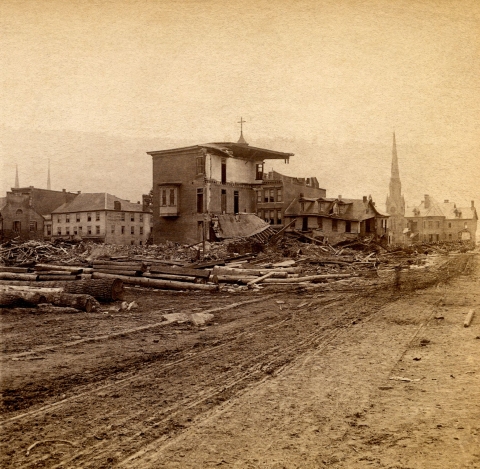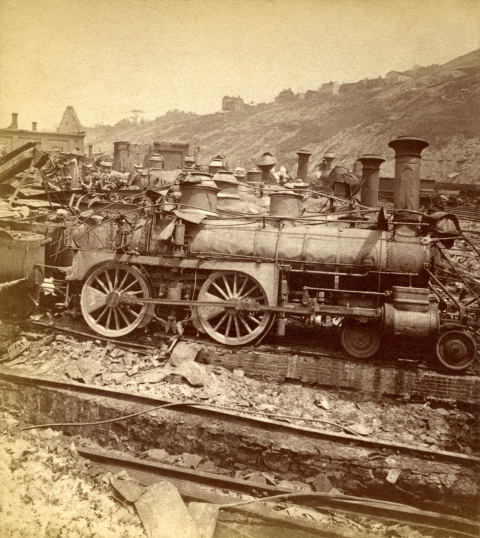A unique collection of stereo photographs, which depict key themes in the 19th century American Industrial Revolution, are to be exhibited for the first time in the UK this month.
Seeing Double: Stereo Photography, Historical Cartography and the US Industrial Revolution 1840-1920 is being shown at the Royal Geographical Society (with IBG), 1 Kensington Gore, London from 17 April to 19 May.
Stereo photographs (or stereoviews) consist of two nearly identical photographs, paired to produce the illusion of a single three-dimensional image, usually when viewed through a stereoscope. Much of the 3D technology of today is based on the simple principles that allow the stereoscope to function.
The exhibition is based on a collection of 19th century stereo photographs and historical maps, which had their origins in the teaching and research of the historical geography of industrial development in the American Manufacturing Belt.

A view of two surviving buildings in central Johnstown Pennsylvania after the destruction of the dam-burst flood wave in 1889.
Through the lens of the stereo photographer, exploring the novel technology of 3D visual effects, the exhibition examines key industrial sectors, such as the railroads, oil production, coal mining and the rise of the iron and steel industry. The varied geographical manifestations of the technologies and developments involved are further examined using a variety of cartographic resources.
This is the first time that images from a large collection of US industrial stereoviews of this kind have been exhibited in the UK, if not in Europe. While some images will be familiar to 19th century photographic historians, others are very rare or are newly discovered. Featured important photographers include the Langenheim Brothers from the 1850s, John Mather, the Oil Regions photographer, from the 1860s, and Frederick Gutekunst from the 1870s.
Likewise, scans of original maps, dating back as far as a railroad map from 1831, are used to illustrate the wider geographical contexts of economic development, as well as pinpointing the locations at which photographs were taken. Where the original images will support it, large format anaglyphs have been created of selected scenes, to allow photos to be studied in 3D and in much greater detail than is possible using small format stereoviewers alone.
The approximately 170 stereoview images in the exhibition bring back to life past landscapes and locations of economic activity previously believed lost or barely referenced in the written documentary record, as well as major upheaval events that achieved national prominence, such as the Pittsburgh Railroad War of 1877 and the Johnstown Flood of 1889.
Professor Richard Healey, School of the Environment, Geography and Geosciences

Stereoview of destroyed Pennsylvania Railroad locomotives in Pittsburgh after the 1877 'railroad war'.
The exhibition is designed and curated by Professor Richard Healey of the School of the Environment, Geography and Geosciences at the University of Portsmouth.
Professor Healey said: "Stereoviews represent an immensely valuable, but strangely neglected resource for the study of historical geography, quite apart from their important place in the history of photography. The approximately 170 stereoview images in the exhibition bring back to life past landscapes and locations of economic activity previously believed lost or barely referenced in the written documentary record, as well as major upheaval events that achieved national prominence, such as the Pittsburgh Railroad War of 1877 and the Johnstown Flood of 1889."
The exhibition runs on weekdays from Monday 17 April to Friday 19 May, with special additional opening dates on the Coronation Bank Holiday Monday (May 8) and Saturday May 20.






